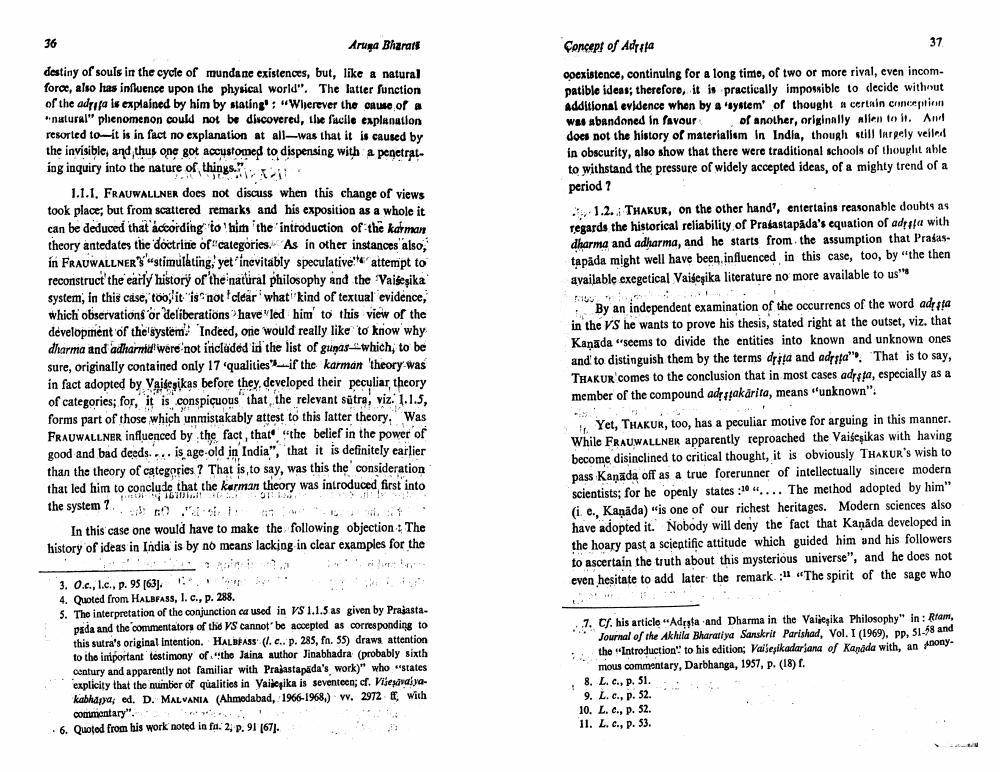Book Title: Note On Concept Adrsta As Used In Vaisesika Sutra Author(s): A Wezler Publisher: A Wezler View full book textPage 2
________________ Concept of Adrata Arura Bharart destiny of souls in the cycle of mundane existences, but, like a natural force, also has influence upon the physical world". The latter function of the adrira is explained by him by stating': "Wherever the one of a "natural" phenomenon could not be discovered, the facile caplanation resorted to it is in fact no explanation at all-was that it is caused by the invisible, and thus one got accustomed to dispensing with a penetrating inquiry into the nature of things. 1.1.1. FRAUWALLNER does not discuss when this change of views took place; but from scattered remarks and his exposition as a whole it can be deduced that according to him the introduction of the karman theory antedates the doctrine of "categories. As in other instances also, in FRAUWALLNERY stimulating, yet inevitably speculative to attempt to reconstruct the early history of the natural philosophy and the Vaiseșika system, in this case, too, it is not clear what kind of textual evidence, which observations or deliberations have led him to this view of the development of the system. Indeed, one would really like to know why dharma and adharmidwere not included in the list of gunas-which, to be sure, originally contained only 17 qualities if the karmant theory was in fact adopted by Vaiseikas before they, developed their peculiar theory of categories; for, it is conspicuous" that the relevant sutra, viz. 1.1.5, forms part of those which unmistakably attest to this fatter theory, Was FRAUWALLNER influenced by the fact that the belief in the power of good and bad deeds.... is age-old in India", that it is definitely earlier than the theory of categories? That is to say, was this the consideration that led him to conclude that the karman theory was introduced first into the system 7. . . . . In this case one would have to make the following objection: The history of ideas in India is by no means lacking in clear examples for the opexistence, continuing for a long timo, of two or more rival, even incompatible ideas; therefore, it is practically impossible to decide without Additional evidence when by 4 ayatem of thought a certain conception Was abandoned In favour of another, originally allen to it. Aul does not the history of materialiem In India, though still largely veiled in obscurity, also show that there were traditional schools of thought able to withstand the pressure of widely accepted ideas, of a mighty trend of a period 7 1.2. THAKUR, on the other hand, entertains reasonable doubts as regards the historical reliability of Prasastapāda's equation of adtala with dharma and adharma, and he starts from the assumption that Prasastapada might well have been influenced in this case, too, by the then available exegetical Vaiseșika literature no more available to us By an independeat examination of the occurrencs of the word adesta in the VS he wants to prove his thesis, stated right at the outset, viz. that Kanada "seems to divide the entities into known and unknown ones and to distinguish them by the terms drita and adrsta". That is to say, THAKUR comes to the conclusion that in most cases adista, especially as a member of the compound adyafakarita, means "unknown" . Yet, THAKUR, too, has a peculiar motive for arguing in this manner. While FRAUWALLNER apparently reproached the Vai esikas with having become disinclined to critical thought, it is obviously THAKUR's wish to pass Kanada off as a true forerunner of intellectually sincere modern scientists; for be openly states:30u.... The method adopted by him" (ie., Kanada) is one of our richest heritages. Modern sciences also have adopted it. Nobody will deny the fact that Kanāda developed in the hoary past a scientific attitude which guided him and his followers to ascertain the truth about this mysterious universe", and he does not even hesitate to add later the remark :41 .The spirit of the sage who 3. 0.c., Lc., p. 95[63]. . 4. Quoted from HALBFASS, 1. c., p. 288. 5. The interpretation of the conjunction caused in VS 1.1.5 as given by Prajasta. pada and the commentators of the VS cannot be accepted as corresponding to this sutra's original intention, HALBFASS (I. c. p. 285, f. 55) draws attention to the inportant testimony of the Jaina author Jinabhadra (probably sixth century and apparently not familiar with Prasastapada's work)" who states explicity that the number of qualities in Vaiorika is seventeen; cf. Visesavaiyakabhaya, ed. D. MALVANIA (Ahmodabad, 1966-1968.) w. 2972 t with commentary". 6. Quoted from his work noted in f. 2. p. 91 (67). ..7. Cf. his article "Adqpfa and Dharma in the Vaidepika Philosophy" in: Rram, Journal of the Akhila Bharatiya Sanskrit Parishad, Vol. I (1969). PP. 51-68 and the Introduction to his edition; Valsekadarsana of Kanada with, an Anony mous commentary, Darbhanga, 1957, p. (18) L. 8. L. c., p. 51. 9. L. c., p. 52. 10. L. c., p. 52. 11. L. c., p. 53.Page Navigation
1 2 3 4 5 6 7 8 9 10 11 12 13
